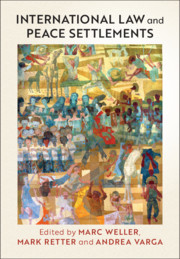Book contents
- International Law and Peace Settlements
- International Law and Peace Settlements
- Copyright page
- Contents
- Contributors
- Preface and Acknowledgements
- Case Law
- Peace Agreements and Instruments
- Abbreviations
- 1 Introduction
- Part I Historical Dimensions to Peace Settlement Practice
- Part II Peace Agreements As Legal Instruments
- Part III Key Actors and the Role of International Law
- 9 Non-state Armed Groups and Peace Agreements
- 10 Witnesses and Guarantors
- 11 The Security Council, Peace-Making and Peace Settlement
- 12 Peace-Making, Peace Agreements and Peacekeeping
- Part IV Representation, Sovereignty and Governance
- Part V Economic Aspects of Peace Settlements
- Part VI Humanitarian Obligations and Human Rights
- Conclusion
- Index
11 - The Security Council, Peace-Making and Peace Settlement
Between Executive and Pragmatic
from Part III - Key Actors and the Role of International Law
Published online by Cambridge University Press: 14 January 2021
- International Law and Peace Settlements
- International Law and Peace Settlements
- Copyright page
- Contents
- Contributors
- Preface and Acknowledgements
- Case Law
- Peace Agreements and Instruments
- Abbreviations
- 1 Introduction
- Part I Historical Dimensions to Peace Settlement Practice
- Part II Peace Agreements As Legal Instruments
- Part III Key Actors and the Role of International Law
- 9 Non-state Armed Groups and Peace Agreements
- 10 Witnesses and Guarantors
- 11 The Security Council, Peace-Making and Peace Settlement
- 12 Peace-Making, Peace Agreements and Peacekeeping
- Part IV Representation, Sovereignty and Governance
- Part V Economic Aspects of Peace Settlements
- Part VI Humanitarian Obligations and Human Rights
- Conclusion
- Index
Summary
While third states and international organisations often co-sign peace agreements in the capacity of witnesses or guarantors, little is understood of the legal consequences flowing from these roles. The chapter aims to fill this gap. First, it highlights that the mere designation of witness or guarantor leads to few consequences. Second, it analyses how specific third-party rights and obligations are established and conceptualised under VCLT rules, extended by analogy to intra-state peace agreements. Third, it provides a brief illustration of common third-party rights and obligations in peace agreements. Finally, it examines whether the involvement of third parties can internationalise an intra-state peace agreement, i.e. render it to be governed by international law. Bringing together views from the literature, jurisprudence and the preceding analysis on the structure of third-party rights and obligations, the chapter concludes that such rights and obligations can be internationalised, in a manner that can only extend to the agreement as a whole when inseparable from the rest of the agreement.
Keywords
- Type
- Chapter
- Information
- International Law and Peace Settlements , pp. 237 - 263Publisher: Cambridge University PressPrint publication year: 2021
- 1
- Cited by

